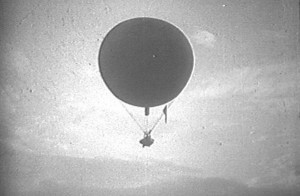Nation’s Oldest Air National Guard Unit Celebrates 100 Years
| DMNA Home page | More News Stories |
Long Island Unit Gave Birth to “Citizen Airmen”
Story by: Eric Durr - Division of Military and Naval Affairs Public Affairs
Dated: Wed, Apr 30, 2008
WEST HEMPSTEAD, NY -- The New York Air National Guard’s 106th Rescue Wing celebrates its 100th birthday Wednesday April 30, making it the oldest Air National Guard unit in the United States.
On April 30, 1908, the First Company, Signal Corps, a New York National Guard unit of 100 men belonging to the 71st Regiment organized to operate observation balloons, held its first training session at the regimental armory in New York City.
Today the descendants of the First Company, Signal Corps, operate state-of-the art HH-60 Pavehawk rescue helicopters and HC-130N Hercules surveillance aircraft designed to locate and rescue downed airmen. 106th Airmen have served in Afghanistan, Iraq and the Horn of Africa. They also provide rescue support during NASA Space Shuttle launches.
Airmen of the 106th were the first on the scene when TWA Flight 800 blew up in mid-air off the Long Island coast in July 1996, and conducted the longest over-water rescue mission ever in 1998. In 1991 HH-60s of the 106th launched on the rescue of a yacht crew that was featured in the movie "The Perfect Storm". And the first woman officer in the Air National Guard belonged to the 106th.
According to the New York Herald of Friday, May 1, 1908, that first training session was " the official beginning of the plan to make aeronautics a part of the study and work of the signal corps. An aeronautic corps of twenty-five men, commanded by Major Oscar Erlandean, has been organized."
"Ascensions are to be made as soon as the work is far enough advanced and arrangements are made for equipment. Balloon construction also is to be taken up."
"For purposes of demonstration there was provided a model balloon, belonging to Albert C. Triaca, director of the American School of Aeronautics," the newspaper reported.
Observation balloons maintained by the Army Signal Corps had been employed in Cuba during the Spanish American War, in which the men of the 71st had fought, as well as in the American Civil War. In the days before airplanes they were used to scout enemy positions and direct artillery fire.
The National Guard Soldiers and Officers who formed that firs balloon squadron later formed the core of the 1st Aero Company, New York National Guard, which was formed in 1915 and trained with JN-4 “Jenny” aircraft. In June 1916 the 1st Aero Company was federalized for service along the Mexican Border in the Army’s quest to find Mexican revolutionary Pancho Villa, who had raided across the border into the United States.
The 1st Aero Company conducted the first mass flight in U.S. military history on Nov. 18 and Nov. 19, 1916 when its 12 planes flew from Mineola, N.Y. to Princeton, N.J. and back the next day.
Following World War I the unit was redesignated the 102nd Observation Squadron of the New York National Guard. When the National Guard became the Army and Air National Guard in 1947, with the founding of the Air Force, the 106th was a light bomber wing.
The unit has flown bombers, transport planes, and jet fighters, before settling into its role as a rescue wing. From 1951 to 1952 the Citizen Airmen of the 106th manned B-29 Superfortress bombers, the same type of plane that dropped the first atomic bombs, on active duty as part of the Strategic Air Command.
Attachments
URL: https://dmna.ny.gov/news/?id=1209558708
216.73.216.141
Page Last Modified: Fri, Jan 16, 2009




